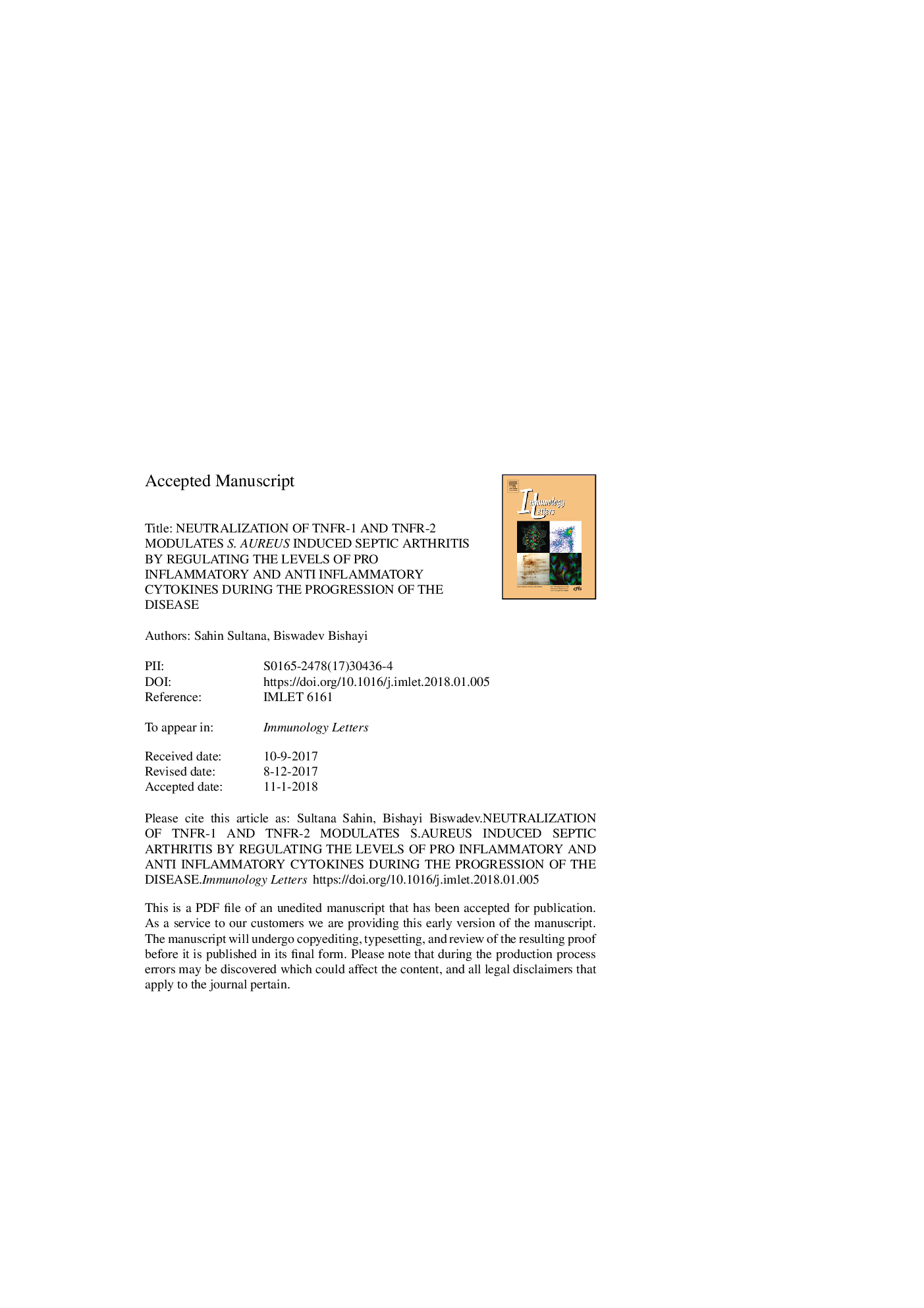| کد مقاله | کد نشریه | سال انتشار | مقاله انگلیسی | نسخه تمام متن |
|---|---|---|---|---|
| 8738323 | 1591530 | 2018 | 54 صفحه PDF | دانلود رایگان |
عنوان انگلیسی مقاله ISI
Neutralization of TNFR-1 and TNFR-2 modulates S. aureus induced septic arthritis by regulating the levels of pro inflammatory and anti inflammatory cytokines during the progression of the disease
دانلود مقاله + سفارش ترجمه
دانلود مقاله ISI انگلیسی
رایگان برای ایرانیان
کلمات کلیدی
c-Jun N terminal kinaseTBSTCyt CIFN-γIL-10IL-1βHBSSPMNiNOSRANKLHRPNADPHPVDFCPCSEAIAECJnkPBSDPINF-κBRoswell Park Memorial Institute-1640RPMI-1640CFUIL-6PGNMPO - DFODMSO - DMSOH2O - H2OO2− - O2-ROS - ROSTLRs - TLR هاcollagen-induced arthritis - آرتروز ناشی از کلاژنenzyme linked immunosorbant assay - آنزیم مرتبط با ایمونوسیستروبنتEDTA - اتیلن دی آمین تترا استیک اسید ethylene diamine tetraacetic acid - اتیلن دیامین تتراستیک اسیدStaphylococcus aureus - استافیلوکوک اورئوسS. aureus - استافیلوکوکوس اورئوسsodium dodecyl sulphate–polyacrylamide gel electrophoresis - الکتروفورز ژل دوده سولفات سدیم پلی آکریل آمیدSDS-PAGE - الکتروفورز ژل پلی آکریل آمیدInterleukin-10 - اینترلوکین 10interleukin-6 - اینترلوکین ۶interleukin-1beta - اینترلوکین-1 بتاRIPA buffer - بافر RIPAanalysis of variance - تحلیل واریانسANOVA - تحلیل واریانس Analysis of varianceELISA - تست الیزاtumor necrosis factor- alpha - تومور نکروز فاکتور آلفاintraperitoneal - داخل صفاقیpolyvinylidene difluoride - دی فلوئورید پلی وینیلیدینDimethyl sulfoxide - دیمتیل سولفواکسیدdays post infection - روز پس از عفونتinducible nitric oxide synthase - سنتاز اکسید نیتریک القاییCIA - سیاcytochrome c - سیتوکروم سیTNF-α - فاکتور نکروز توموری آلفاnuclear factor kappa B - فاکتور هسته ای کاپا BPhosphate buffered saline - فسفات بافر شورLuria–Bertani - لواریا بارتانیToll like receptors - مانند گیرنده هاHank’s balanced salt solution - محلول نمک متعادل هانکmyeloperoxidase - میلوپراکسیداز Polymorphonuclear neutrophils - نوتروفیل های پلیمورون هسته ایNitric oxide - نیتریک اکسیدnicotinamide adenine dinucleotide phosphate - نیکوتین آمید adenine dinucleotide phosphatePeptidoglycan - پپتیدوگلیکانcolony forming unit - کلنی واحد تشکیلInstitutional Animal Ethical Committee - کمیته اخلاقی حیوانات نهادCommittee for the Purpose of Control and Supervision of Experiments on Animals - کمیته هدف کنترل و نظارت بر آزمایشات روی حیواناتInterferon gamma - گاما اینترفرونReactive oxygen species - گونههای فعال اکسیژنreceptor activator of nuclear factor kappa-B ligand - گیرنده گیرنده لیگاند کاپا-B فاکتور هسته ای
موضوعات مرتبط
علوم زیستی و بیوفناوری
ایمنی شناسی و میکروب شناسی
ایمونولوژی
پیش نمایش صفحه اول مقاله

چکیده انگلیسی
Staphylococcal septic arthritis remains a serious medical concern due to rapid and sustained production of inflammatory cytokines that leads to progressive and irreversible joint destruction with high mortality rate in patients despite adequate antibiotics treatment. TNF-α signalling via TNFR-1 contributes to arthritic destruction by aggravating inflammation. Impact of TNFR-2 signalling is not well established in this aspect. Hence the objective of our study was to evaluate the role of dual neutralization TNFR-1 and TNFR-2 in the pathogenesis of S. aureus infection induced septic arthritis. Mice were infected with live S. aureus (5â¯Ãâ¯106â¯cells/ml) followed by administration of TNFR-1and TNFR-2 neutralizing antibody. To measure arthritis index and osteoclastogenesis, histology result in joint tissue and TRAP staining images of arthritis joints have been performed respectively. Maximum reduction in the joint and paw swelling was observed in infected mice treated with both TNFR-1 and TNFR-2 antibody. NF-κB signalling was found to be mainly regulated by TNFR-1 whereas TNFR-2 significantly modulated JNK pathway. Lowest levels of inflammatory cytokines like TNF-α, IL-1β, IL-6, and IFN-γ were observed in both serum and synovial tissues signifying maximum protection in S. aureus arthritis during combination treatment. However IFN-γ and IL-10 levels were significantly altered by TNFR-2 neutralization that indicates both pro and anti inflammatory role of TNFR-2 respectively. Highest decrement in ROS concentration, iNOS expression with least MPO and lysozyme activity was detected in case of combined neutralization. During the early phase of infection all the aforesaid inflammatory parameters remained elevated due to lack of IL-10 as a result of TNFR-2 neutralization as IL-10 negatively modulates pro inflammatory cytokines. Increase in inflammatory cytokines during early phase might also be responsible for decreased bacterial count in TNFR-2 neutralized groups. Thus it can be suggested that combined administration of TNFR-1 and TNFR-2 antibody has a beneficial effect against the severity of S. aureus induced arthritis.
ناشر
Database: Elsevier - ScienceDirect (ساینس دایرکت)
Journal: Immunology Letters - Volume 196, April 2018, Pages 33-51
Journal: Immunology Letters - Volume 196, April 2018, Pages 33-51
نویسندگان
Sahin Sultana, Biswadev Bishayi,